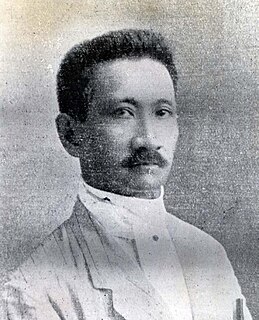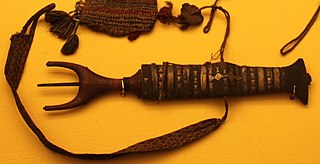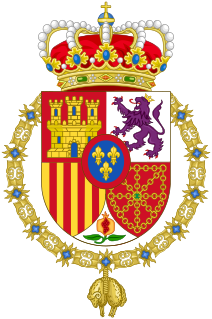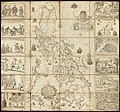
The Philippines, officially the Republic of the Philippines, is an archipelagic country in Southeast Asia. Situated in the western Pacific Ocean, it consists of about 7,641 islands that are categorized broadly under three main geographical divisions from north to south: Luzon, Visayas and Mindanao. The capital city of the Philippines is Manila and the most populous city is Quezon City, both part of Metro Manila. Bounded by the South China Sea on the west, the Philippine Sea on the east and the Celebes Sea on the southwest, the Philippines shares maritime borders with Taiwan to the north, Japan to the northeast, Vietnam to the west, Palau to the east, and Malaysia and Indonesia to the south.
Juan de Salcedo was a Spanish conquistador. He was born in Mexico in 1549 and he was the grandson of Miguel López de Legazpi and brother of Felipe de Salcedo. Salcedo was one of the soldiers who accompanied the Spanish colonization of the Philippines in 1565. He joined the Spanish military in 1564 for their exploration of the East Indies and the Pacific, at the age of 15. In 1567, Salcedo led an army of about 300 Spanish and Mexican soldiers and 600 Visayan (Filipino) allies along with Martín de Goiti for their conquest of Islamic Manila. There they fought a number of battles against the Muslim leaders, mainly against Tarik Sulayman. The Spanish officers, Mexican recruits and Filipino warriors coalesced in 1570 and 1571 to attack the Islamised areas of Luzon, for control of lands and settlements.

Tondo is a district located in Manila, Philippines. It is the largest in terms of area and population of Manila's sixteen districts, with a Census-estimated 631,313 people in 2015 and consists of two congressional districts. It is also the most densely populated district in the city.

According to the indigenous religious beliefs of the Tagalog people, Bathala is the all-mighty deity who created the universe. A descriptive honorific is often attached to his name, describing him as the Bathalang Maylicha and as the Bathalang Maycapal.

Jacques Nicolas Bellin was a French hydrographer, geographer, and member of the French intellectual group called the philosophes.

Scarborough Shoal, also known as Huangyan Dao ,, Bajo de Masinloc (Spanish),, and Democracy Reef are two rocks in a shoal located between the Macclesfield Bank and Luzon island in the West Philippine Sea.

The Ayala Museum is a museum in Makati, Metro Manila, Philippines. It is located in Ayala Center adjacent to Greenbelt mall and is run privately by the Ayala Foundation. This six-storey edifice houses ethnographic and archaeological exhibits on Filipino culture, art, and history. Since its establishment in 1967, the museum has been committed to showcasing overseas collections and situating contemporary Philippine art in the global arena in a two-way highway of mutual cooperation and exchange with local and international associates.

Epifanio de los Santos y Cristóbal, sometimes known as Don Pañong or Don Panyong was a noted Filipino historian, literary critic, art critic, jurist, prosecutor, antiquarian, archivist, scholar, painter, poet, musician, musicologist, philosopher, philologist, bibliographer, translator, journalist, editor, publisher, paleographer, ethnographer, biographer, researcher, civil servant, patriot and hero. He was appointed Director of the Philippine Library and Museum by Governor General Leonard Wood in 1925.
Manuel Artigas y Cuerva was a historian and journalist. He was born in Tacloban, Leyte, on October 15, 1866. His parents were Miguel Artigas y Rodriguez, a Spaniard from Cadiz, Spain and Soledad Cuerva y Molina of Bulacan. They were originally from Baler but they moved to Leyte in 1860 when Soledad's father, an officer in the artillery corps, was transferred.

The Political Constitution of 1899, informally known as the Malolos Constitution, was the basic law of the First Philippine Republic. It was written by Felipe Calderón y Roca and Felipe Buencamino as an alternative to a pair of proposals to the Malolos Congress by Apolinario Mabini and Pedro Paterno. After a lengthy debate in the latter part of 1898, it was promulgated on 21 January 1899.
Dimasaua, also spelled Dimasawa and Dimasava, was the invented name created by 17th-century Spanish missionary Fr. Francisco Colín, S.J., pointing to a tiny isle in southern Leyte whose chief, according to Colín, "gave the most signal service" to Ferdinand Magellan and his crew at the port of Butuan in March–April 1521.

The name Philippines derives from that of the 16th-century Spanish king Philip II, and is a truncated form of Philippine Islands. During the expedition of Ruy López de Villalobos to the region, the Spanish sailor Bernardo de la Torre bestowed the name Las Islas Filipinas on the islands of Leyte and Samar, in honor of the then Prince of Asturias. Despite the existence of other names, Filipinas ("Philippines") was eventually adopted as the name of the entire archipelago.

The Doctrina Christiana was an early book on the Catholic Catechism, written in 1593 by Fray Juan de Plasencia, and is believed to be one of the earliest printed books in the Philippines.
1898 in the Philippines details events of note that happened in the Philippines in the year 1898.

The Philippines–Spain relations is a bilateral and multilateral relations between the Philippines and Spain.

The Confederation of Madya-as was a legendary pre-Hispanic supra-barangay polity in island of Panay in Philippines. It was mentioned in Pedro Monteclaro's book titled Maragtas. It was supposedly created by Datu Sumakwel to exercise his authority over all the other datus of Panay. Like the Maragtas and the Code of Kalantiaw, the historical authenticity of the confederation is disputed, as no other documentation for Madya-as exists outside of Monteclaro's book.

Caboloan, referred to Chinese records as Feng-chia-hsi-lan, was a sovereign pre-colonial Philippine polity located in the fertile Agno River basin and delta, with Binalatongan as the capital. The polity of Pangasinan sent emissaries to China in 1406–1411.

Fernando Canon Faustino y Alumno , was a Filipino revolutionary general, poet, inventor, engineer,musician and Philippines 1st National Chess Champion on 1908.

Balarao, also known as "winged dagger", is a Filipino dagger used throughout the pre-colonial Philippines. It is unusually shaped, with a leaf-like blade and a finger-fitting grip consisting of two horn-like projections at the pommel and no guards. The tang also protrudes at the back. The dagger is a status symbol among nobility and warriors and is usually finely-worked with precious metals, ivory, and horn.































